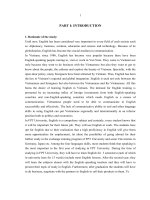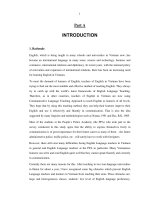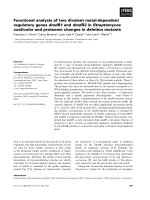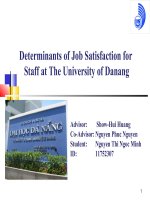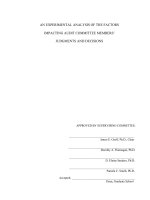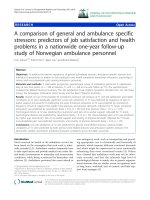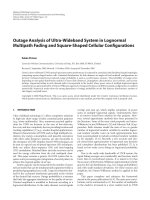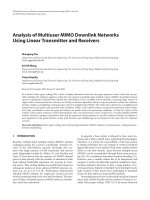analysis of job satisfaction level at delta civil construction and industries public company limited
Bạn đang xem bản rút gọn của tài liệu. Xem và tải ngay bản đầy đủ của tài liệu tại đây (584.01 KB, 77 trang )
Thai Nguyen University
Socialist Republic of Vietnam
Southern Luzon State University
Republic of Philippines
ANALYSIS OF JOB SATISFACTION LEVEL AT DELTA CIVIL
CONSTRUCTION AND INDUSTRIES PUBLIC COMPANY LIMITED
A RESEARCH PAPER PRESENTED TO THE FACULTY
OF THE GRADUATE SCHOOL SOUTHERN LUZON STATE
UNIVERSITY, LUCBAN, QUEZON, PHILIPPINESIN
COLLABORATION WITH
THAI NGUYEN UNIVERSITY, SOCIALIST REPUBLIC
OF VIETNAM
IN PARTIAL FULFILLMENT OF THE
REQUIREMENTS FOR THE DEGREE
DOCTOR OF BUSINESS ADMINISTRATION
(DO THUY DUNG - LINDA)
ii
AUGUST, 2013
iii
ACKNOWLEDGMENTS
I would like to express our most sincere thanks to the Management
Board of the Southern Luzon State University, Thai Nguyen University, the
teacher, the teacher of the school has helped me facilitate the learning
process throughout.
I would like to express sincere gratitude and profound Professor
Walberto A. Macaraan, enthusiastic teacher who have dedicated guidance,
encouragement, spend time and exchange orientation for me during this
research.
I would like to express my sincere thanks to the Delta Civil Construction
and Industries Public Company Limited. The company has helped me research
material, through a questionnaire survey.
I sincerely thank the Board of the University of Labor and Social affair
(ULSA), colleagues in ULSA, classmates DBA1 facilitated enthusiastic help
and share my experience to help complete the thesis.
Finally, I would like to send the gift to the heart of my family has passed
enthusiasm and encouragement to complete my thesis.
iv
TABLE OF CONTENT
ACKNOWLEDGMENTS iii
LIST OF TABLES vii
LIST OF FIGURES ix
CHAPTER 1. INTRODUCTION 1
1.1. Rationale 1
1.2. Background of the company 2
1.3. Statement of the Problem for the Research Study 2
1.4. Objectives of the Research Study 3
1.5. Conceptual Framework of the Research Study 3
1.6. Scope of the Research Study 5
1.7. Methodology for the Research Study 5
1.7.1. Primary data 5
1.7.2. Secondary data: 5
1.8. The Expected Contributions of the Research Study 5
1.9. Limitation of the Research Study 6
1.10. Organization of the Research Study 6
CHAPTER 2. LITERATURE REVIEW 7
2.1. Definitions of Job Satisfaction 7
2.2. Theories of Job Satisfaction 8
2.2.1. Locke’s Value Discrepancy Theory 8
2.2.2. Lawler’s Facet Theory 9
2.2.3. Work Adjustment Theory 11
2.3. Factors affect job satisfaction 13
2.3.1. The nature of jobs 14
2.3.2. Salary 14
2.3.3. Colleagues 15
2.3.4. Leadership 15
2.3.5. Training opportunities and getting promotion: 15
2.3.6. Working environments 16
2.4. Some research results of job satisfactions of labors. 16
2.4.1. Andrew ‘S research(2002) 16
v
2.4.2. Tom’s research (2007) 17
2.4.3. Research of Tran Kim Dung and her corporators: 17
2.4.4. Research of Keith and John 18
2.5. Research model 18
CHAPTER 3: RESEARCH METHODS 21
3.1.
Research design 21
3.1.1.
Research methods 21
3.1.2.
Research process 22
3.2.
Official research 24
3.2.1.
Designing by questions 24
3.2.2.
Expression and coding scales 24
3.2.3.
Evaluating measurement scales 27
3.2.4.
Research design 29
CHAPTER 4: RESULTS OF RESEARCH 30
4.1.
Collected data 30
4.2.
Scale evaluation 32
4.1.1. Results of evaluation scale factors affecting job satisfaction in employees
in Delta Civil Construction and Industries Public Company Limited 32
4.2.1.
Scales to assess satisfaction 35
4.3.
FACTORS ANALYSIS 36
4.3.1.
Results of factors analysis 36
4.3.2.
Naming and explaining factors 38
4.3.3.
Interpretation of results 38
4.4.
Adjustment model 39
4.4.1.
Contents of adjusment 39
4.4.2.
Hypothesis for adjustment model 39
4.5.
Testing factors of model 40
4.5.1.
Inspection of the correlation coefficient 40
4.5.2.
Regression analysis 40
4.6.
Testing hypothesis 43
4.7.
Inspection of the difference in the lwvels of satisfaction according to
individual charasteristics 45
vi
4.7.1.
Testing the impact of different levels of age toward job satisfaction of
employees in Delta Manufacturing and Engineering Joint Stock
Company. 47
4.7.2.
Testing differences in “ qualifications” toward job satisfaction of
employees in Delta Manufacturing and Engineering Joint Stock Company 48
4.7.3.
Table 4.21: Results of One-Way ANOVA compare levels of job
satisfaction according to “ seniority” 48
4.7.4.
Inspection of the different impacts of "departments" toward levels of job
satisfaction of the employees in Delta Civil Construction and Industries
Public Company Limited 49
4.8.
Statistical results on levels of satisfaction levels of satisfaction in
general and groups of factors 50
4.8.1.
General satisfaction 50
4.8.2.
Satisfaction in each group element 50
4.8.2.1. Levels of satisfaction factor according to group "colleagues" 50
CHAPTER 5: CONCLUSIONS 56
5.1.
A summary of the study 56
5.2.
Summary of research findings 57
5.3.
Some solutions to increase levels of job satisfaction of working staff in
delta civil construction and industries public company limited 58
5.3.1.
Colleagues issues 61
5.3.2.
Leadership issues 62
5.4.
Limitations of the research and next research direction 64
5.4.1
Linitations of the research 64
5.4.2
Next research direction 64
BIBLIOGRAPY 66
vii
LIST OF TABLES
Table 3.1: Mesurement scales and coding measurement scales 25
Table 3.2: Mesurement scales and coding measurement scales 26
Table 4.1: Gender structure 30
Table 4.2: Age structure 31
Table 4.3: Structure of qualifications 31
Table 4.4: Seniority structure 31
Table 4.5: Structure of departments 32
Table 4.6: Cronbach Alpha of scale “ nature of work” 32
Table 4.7: Cronbach Alpha of scale “salary” 33
Table 4.8: Cronbach Alpha of scales “ colleagues” 33
Table 4.9: Cronbach Alpha of scales “leaders” 34
Table 4.10: Cronbach Alpha of scales “training and promotion opportunities”. 34
Table 4.11: Cronbach Alpha of scale “ working environment” 35
Table 4.12: Cronbach Alpha of scales “satisfaction” 35
Table 4.13: Results of step 2 of model 37
Table 4.14: Model summary of method Enter. 41
Table 4.15: The regression results using the method Enter. 41
Tabled 4.16: Results of using the method Enter after removing variables. 42
Table 4.17: Results of Independent t-test Statistics according to groups of
genders 46
Table 4.18: Results of Independent t-test compare levels of job satisfaction
according to genders. 46
Table 4.19: One-Way ANOVA Results compare levels of job satisfaction
according to the age. 47
Table 4.20: Results of One-Way ANOVA compare job satisfaction according
to qualifications 48
Table 4.22: Results of One-Way ANOVA compare levels of job satisfaction
according to departments. 49
viii
Table 4.23: Results Descriptive statistics overall satisfaction level 50
Table 4.24: Results of research according to levels of satisfaction factor
according to group "colleagues" 51
Table 4.25: Results Descriptive statistics of the satisfaction level of "3
colleagues” 51
Table 4.26: Results Descriptive statistics of the satisfaction level of the
"colleagues 4" 52
Table 4.27:. Results of descriptive statistics of the satisfaction level of
"colleagues 1" 52
Table 4.28: Results of statistics describing satisfaction of component “
leadership” 53
Table 4.29: Results Descriptive statistics of the satisfaction level of "2 colleagues." 54
ix
LIST OF FIGURES
Figure 1.1 Research Framework for this research study 4
Figure 2.1 Lawler’s model of job satisfaction and its determinants 10
Figure 2.2 Work adjustment model 12
Graph 2.1 Research model 19
Graph 3.1 Research process 23
Graph 4.1 Adjustment model 39
1
CHAPTER 1. INTRODUCTION
1.1. Rationale
Specific employee attitude relating to job satisfaction is one of the major
interests to the field of organizational behavior and the practice of human
resource management. Job satisfaction is one of the most researched areas in
Industrial and Organizational (I/O) Psychology. It estimated that over 3,000
articles have been written on the topic. The subject has aroused so much
interest because of three main reasons.
First, it is cultural in the sense that as a nation that values individual
freedom, personal growth, and opportunity. For example, in certain European
countries, like Germany, Sweden and Holland, there has been a long-standing
concern for industrial democracy, in which the feelings of workers are of
major importance. However, in some other European countries and in other
parts of the world, interest in the quality of work life is emerged (De Wolff &
Shimmin, 1976).
The second reason for interest in job satisfaction is functional. Some
research studies have shown that satisfaction is related to other important
variables like absenteeism, turnover, and performance. Though we do not
know if job satisfaction has a causal relationship with these variables (for
example, if high job satisfaction will cause a worker to be absent less often),
we do know that feelings of high job satisfaction are associated with certain
levels of these variables. Because the company wants less absenteeism, less
turnover and better performance, then increasing job satisfaction might help
in meeting these objectives.
Finally, there is a historical basis to job satisfaction research. The
studies began in the 1920s as research on the effects of work and illumination
2
on productivity, but the emphasis soon shifted to attitudes. In the late 1950s
and early 1960s, attention was given to designing jobs that were more
satisfying, This early research was the nucleus for current work on changing
the environment (design jobs) to improve work life.
This is clearly visible that job satisfaction is an important consideration
for manager as specific attitude of employees maybe related to critical
behaviors such as absenteeism and turnover. The theory and research on job
satisfaction can be useful to managers by helping them understand employee
attitudes about the workplace.
1.2. Background of the company
Delta Civil Construction & Industries Public Company Limited (DCI)
has been established since 1984. It is located at Rojana Industrial Park in
Ayutthaya, Thailand. The company provides architecture design and
construction consultations and also serves as a main or sub contractor of many
civil construction projects.
1.3. Statement of the Problem for the Research Study
The researcher has aimed to study different factors behind job
satisfaction and use Delta Civil Construction & Industries Public Company
Limited (DCI) as a case study. The company is facing a problem about high
turnover of employee
1
. This has led to the management’s concern on labor
productivity as it takes sometime for the company to train these workers to
achieve their expected level of performance on the job. The causes for labor
turnover may result from many reasons both from employees themselves and
the organization. From organizational perspective, employee turnover can
represent a significant cost in terms of lost recruiting, training, socialization
investments, disruption and replacement costs, and a variety of indirect costs.
1
From discussion with Ms. Banyai Utungkas, Vice President of Industrial Relationships, and Ms. Sasinunt
Srisala, Personnel Section Manager, in 2000, there were total 2,615 employees, the employee turnover rate
was as high as 5.3 percent per month, that was about 125 employees per month.
3
From the theoretical view, factors behind this problem could be
satisfaction of employees. The researcher has been informed that no employee
attitude survey has been done before by the Human Resource Management of
the company. Thus, this research study is designed to identify the factors
behind job satisfaction. Moreover, the researcher expects that having this
information may allow human management to capitalize on ‘satisfiers’ when
planning and updating recruitment and retention programs and thereby to
reduce unnecessary fiscal loss.
1.4. Objectives of the Research Study
The major objective of the study is to find out different factors behind
job satisfaction of employees in Delta Civil Construction & Industries Public
Co., Ltd. The following specific objectives will be considered:
♦ To study employees’ job satisfaction level in the company.
♦ To study the different factors that affect to job satisfaction of
employees in the company.
♦ To give some useful recommendations to improve employee’s
satisfaction in the company.
1.5. Conceptual Framework of the Research Study
This research study will include four main parts:
The literature review will be undertaken formulate conceptual
framework deriving from various the theories of job satisfaction and different
factors and components that concern employee’s attitudes.
The second part is devoted to the research methodology which
includes research design, target population, instrument and scale
construction, methods of observation and measurement, and methods of
obtaining and analyzing data.
4
By analyzing the data collected from the field, this part is the description
of the respondents, results of research study and discussion.
The conclusion and recommendations will be given to human resource
practitioners for future human resource management and development in the
organization.
The summary of this study’s Research Framework is presented in Figure 1.1
Figure 1.1 Research Framework for this research study
1. Literature Review
3. Data Collection
4. Analysis and
discussion
5. Conclusion and
Recommendations
2. Conceptual Framework
3.1 Primary Data 3.2 Secondary Data
5
1.6. Scope of the Research Study
The study focuses on studying different factors that have impact on
employee's job satisfaction level. The main focus of the present study is
managerial practice for Human Resource Management.
The researcher highlights the significant effect of influences on overall
job satisfaction and relationship between job satisfaction level and other
variables. Finally, implications of the findings are provided.
1.7. Methodology for the Research Study
1.7.1. Primary data
This research study conducts a questionnaire survey to obtain the
primary data.
1.7.2. Secondary data:
The information has been extracted from the sources such as previous
research, newspaper, magazines, journals and internet.
1.8. The Expected Contributions of the Research Study
This study is expected to contribute the following:
♦ Knowledge and understanding of the factors, which affect the
employee's job satisfaction level of the company,
♦ An understanding of a priority of the significant factors which affect
employee's job satisfaction level of the company, and
♦ Knowledge of employee's job satisfaction and result of the research
study can be used in the continuous improvement process of management,
especially in Human Resource Management, in order to reduce the employee
turnover rate and other outputs, which may be caused from employee's
satisfaction.
6
1.9. Limitation of the Research Study
As we know every study has its own strength and weakness. Also, this
research study can not avoid its own limitation. Since this study was
conducted only at Delta Civil Construction & Industries Public Company
Limited, therefore the findings could be good only for this place because
different organizations have different policy, philosophy of thinking and
management, including job nature and working environments. Thus the future
research could focus on a bigger scale of subjects and cover more companies,
which have more a variety of product groups and whole industries, so that the
finding of the study can be generalized and widely used in the management
areas. In addition, the comparative study between the government sector and
private sector can add more interesting knowledge to the human resource
management area.
1.10. Organization of the Research Study
Chapter 1: Introduction
Chapter 2: Literature Review
Chapter 3: Research Methodology
Chapter 4: Finding and Data Analysis
Chapter 5: Conclusion and Recommendation
7
CHAPTER 2. LITERATURE REVIEW
Job satisfaction is one among many important attitudes that influence
human behavior in the workplace. It is closely related to organizational
commitment. Thus, job satisfaction is one of the major interests to the field of
organizational behavior and the practice of human resource management.
2.1. Definitions of Job Satisfaction
Job satisfaction is a set of favorable or unfavorable attitudes that
employees hold about their work. Early definitions (e.g., Blum & Naylor,
1968) emphasized job satisfaction as a general attitude resulting from specific
attitudes in three areas: job factor, individual characteristics, and group
relationships outside work.
Later definitions emphasized the affective, or subjective, nature of these
feelings. For example, Locke (1976) defines job satisfaction as a pleasurable
emotional state resulting from the appraisal one makes of his or her job or
job experiences. Dawis and Lofquist (1984) defines job satisfaction as a
feeling based on the worker’s estimate of the extent to which the work
environment fulfills one’s needs.
Though job satisfaction has been defined in various ways, the notion of
subjective feelings such as ‘liking and disliking’ (Hoppock, 1935) and
‘affective responses’ (Smith, Kendall, & Hulin., 1969) and the existence of
needs that have to be fulfilled (e.g., Dawis, 1991; Locke, 1976) run through
most of these definitions. Feelings identify satisfaction, and needs explain the
process.
According to Dawis (1991) and Dawis and Lofquist (1984), the
definition of needs takes into account the individual’s requirement for
particular reinforcers and the level of significance the individual assigns to
8
each reinforcer. A need is a necessity; it is a lack of something that is useful,
required, or desired (Webster’s New World Dictionary or American English,
1994). These needs, inclinations, or tendencies lead to motivation, because
they are intrinsic to the different actions we take to secure specific outcomes.
These outcomes are important because they affect the organization’s
productivity, turnover, and absenteeism. Individual consequences, such as
stress and mental health difficulties, affect not only individual employees but
also the organization as a whole.
2.2. Theories of Job Satisfaction
Several theories have been proposed to explain why people are satisfied
with their jobs. However, none of them have garnered a great deal of
empirical confirmation, which suggests that job satisfaction is a complex
phenomenon with many causal bases and that no one theory has been
successful in incorporating all of them.
2.2.1. Locke’s Value Discrepancy Theory
Edwin A. Locke (1969, 1967) uses the discrepancy hypothesis in value
discrepancy theory. Locke’s basic proposition is that satisfaction with some
factors or aspects of the job is the result of a dual judgment. First, a person
judges the job factor in terms of its importance. This judgment reflects the
intensity of the value relating to the job factor. Second, the person estimates
the discrepancy or difference between how much of the factor is desired and
how much is reDCIved.
Thus, satisfaction with a job factor will depend on the importance of the
factors and there is no difference between what is desired of it and what is
received. Locke further proposes that a factor’s importance affects the
intensity of the reaction to a discrepancy, and there is evidence that this is
9
correct. That is, when a job factor is very important, a discrepancy matters
more and leads to greater dissatisfaction than when the factor is not important
(McFarlin & Rice, 1992)
There is some support for these discrepancy predictions. First,
satisfaction is greater when discrepancies are smaller—or when you get what
you expect. Second, negative discrepancies or getting less than desired, are
associated with dissatisfaction on any job factor. Third, a positive discrepancy
can lead to dissatisfaction on some job factors, such as having more contact
with customers than desired (Rice, McFarlin, & Bennett,1989).
2.2.2. Lawler’s Facet Theory
Lawler (1971)’s facet satisfaction model is a combination of a process
theory, an equity theory, and a theory that accounts for individual difference
in terms of subjective perception.
Facet satisfaction theory accounts for individual differences by
emphasizing personal perceptions and subjective beliefs. As shown in Figure
2.1, a person’s job input includes factors such as skills, age, training, and
abilities. Perceived job demands influence the person’s feelings about what
his or her outcomes should be, compared to the referent other’s inputs and
outcomes. This concept is taken directly from equity theory and emphasizes
the importance of the way we perceive reality, not reality itself (Lawler, 1973;
Milbourn, 1980).
The best summary of the model is provided by Lawler (1973, 1991) and
Lawler and Rhode (1976, p.30): “Job satisfaction is best thought of as a
reaction people have to what happens to them at work.” Each person has his
or her own mental map of behaviors to chooses from and outcomes that will
satisfy the person’s needs. Thus, organizations should provide employees
10
with rewards that are perceived as having value. Some implications of this
model include the following:
♦ People expect that input will be proportionate to output. Accordingly,
people with high levels of input should receive greater rewards (such as more
money) than people with lower input, or they will be dissatisfied.
♦ Most people believe that the more difficult the (perceived) job
demands, the higher the perceived rewards. If this relationship is not
satisfactory, the employee will be dissatisfied.
Figure 2.1 Lawler’s model of job satisfaction and its determinants
S
kil
l
Experience
Training
Effort
Age
Seniority
Education
Company loyalty
Past performance
Present performance
Leve
l
Difficulty
Timespan
Amount of
res
p
onsibi
l
it
y
Perceived job
Characteristics
Perceived persona
l
job inputs
Perceived inputs and
outcomes of referent
others
Perceived amount
that should be
received
Perceived outcomes of
referent others
A
ctual outcomes
reDCIved
A=BÆsatisfaction
A>BÆdissatisfaction
A<BÆguilt, inequity,
discomfortable
a
Perceived
Amount
Received
b
11
2.2.3. Work Adjustment Theory
Dawis and Lofquist (1984) defined tenure as the amount of time an
individual remains on the job. The purpose of work adjustment theory is to
predict the probability that the individual will adjust to his or her environment
and the length of time the individual will stay at the job. The primary factor
affecting tenure is satisfaction; tenure is related to both the employee’s
satisfaction with the job (satisfaction) and the employer’s satisfaction with the
employee’s quality of performance (satisfactoriness). The theory’s
assumption is that employee with substantial tenure are satisfied with their
work environment and are satisfactory to the work environment. This theory
was developed as the result of extensive research conducted during the Work
Adjustment Project at the University of Minnesota (1969). Katzell (1994)
described it as an inductive approach, built on the accumulation of research
information over the years. Figure 2.2 illustrates, Dawis and Lofquist’s (1984)
is explanation of the theory.
12
Figure 2.2 Work adjustment model
(Source: A psychological Theory of Work Adjustment (p. 62), by R.V.
Dawis and L. H. Lofquist, 1984)
Work adjustment theory states that “work adjustment can be predicted
from the correspondence of the work personality and the work environment”
(Dawis & Lofquist, 1984, p.57). The correspondence between the individual’s
abilities and the ability requirements for the job (illustrated by the top two
Correspondence
Degree of
Satisfactoriness
Promote
Transfer
Fire
Retain
Abilities to
perform the job
Abilities and
Skills Required
Ability
Requirement
Individual Need
and
Values
Reinforces
Provided
Correspondence
Tenure
Remain
Reinforcer
Pattern
Quit
Degree of
Satisfaction
Individual Work
Personality
Work
Environment
New Job
13
boxes in the left half of Figure 2.2) leads to a degree of Satisfactoriness. The
degree of Satisfactoriness leads to one of four employer determined work
outcomes: The individual is retained, transferred, promoted, or fired.
From the individual’s perspective, the correspondence between the
individual’s needs and values and the reinforcer patterns provided by the job
(illustrated by the lower boxes in the left half of Figure 2.2) leads to a degree
of satisfaction. The degree of satisfaction leads to one of two employees
determines work outcomes: The person remains on the job or quits. As
illustrated by the model, both Satisfactoriness and satisfaction are necessary
for the individual to remain on the job. Thus “tenure is the outcome of work
adjustment” (Dawis & Lofquist, 1984, p. 56). Any of the other
Satisfactoriness or satisfaction outcomes results in a new job for the
individual and a new process of work adjustment.
The theory has been used to predict employee turnover and adjustment to
career and vocational counselling and has contributed to research on job
satisfaction, person environment fit, and person-organization fit (Chatman,
1989; Katzell, 1994; O’Reilly, Chatman, & Caldwell, 1991).
2.3. Factors affect job satisfaction
Scale level of satisfaction with components of the most famous in the
world is the job description Index (JDI) of Smith (1969). The value and
reliability of the JDI was appreciated in both practical and theoretical (Price
Mayer and Schoorman 1992 to 1997).
Smith (1967) for the 5 factors that affect job satisfaction include
satisfaction with work, satisfaction with supervision, satisfaction with pay,
satisfaction with advancement opportunities and agreed meet with colleagues.
14
Based on the results of previous studies on job satisfaction and the actual
situation in the company, this research selects the factors affecting job
satisfaction in the following: the nature jobs, wages, colleagues, leadership,
training opportunities and advancement, work environment. These factors are
identified will affect the level of job satisfaction of employees, the change of
the elements in a good way or bad will increase or decrease the level of
complacency in the work of workers.
Factors affecting job satisfaction in the research including:
2.3.1. The nature of jobs
The nature of jobs includes factors, job characteristics which affect
working results of labors. In this research, these following factors of job will
be considered, including:
2.3.1.1. Jobs allow to make use of individual capacities .
2.3.1.2. Jobs are very interesting.
2.3.1.3. Jobs have a lot of challenges.
2.3.1.4. It is clear to see results of work finishing.
2.3.2. Salary
According to Stanton and Croddley (2000), the salary satisfaction relates
to working staffs’ feelings about the justice of salary payment.
Salary satisfaction is measured based on criteria:
2.3.2.1. Labors are highly paid
2.3.2.2. Labors can completely live based on income from companies.
2.3.2.3. Salary is commensurate with working results.
2.3.2.4. Salary and income are fairly paid.
15
2.3.3. Colleagues
Colleagues are feelings related to behaviors, relationships with
colleagues in working in working places, corporation and helping each other
in working with colleagues. Colleagues’ factors are considered, including:
2.3.3.1. Colleagues feel comfortable and pleasant.
2.3.3.2. Corporation between labors and colleagues in working.
2.3.3.3. Colleagues’ friendliness.
2.3.3.4. Helping each other among colleagues.
2.3.4. Leadership
Leaders are feelings related to behaviors, relationship with leaders in
working in working places, encourage and supporting of leaders so as to
understand responsibility scope and well-job finishing. Leadership factors are
considered, including:
2.3.4.1. Supervisors ask for ideas when issues relate to labor’s jobs.
2.3.4.2. Supervisors’ supporting for labors.
2.3.4.3. Leaders’ styles are polite and gracious.
2.3.4.4. Working staff are treated equally, no discrimination.
2.3.5. Training opportunities and getting promotion:
According to Stanton and Croddley (2000), training opportunities and
getting promotion relate to working staff’s awareness about training
opportunities, individual capacities development and promotion opportunities
in organizations. Working staff are looking forward to seeing information
about companies’ conditions, opportunities, promotion policies, training
opportunities and necessary skills developments, career orientation for them.
Factors of training opportunities and getting promotion are considered,
including:
16
2.3.5.1. Promotion opportunities for labors.
2.3.5.2. Companies’ promotion opportunities are fair
2.3.5.3. Companies create many opportunities for labors to develop
themselves.
2.3.5.4. Labors are trained for working and working developments.
2.3.6. Working environments
Working environments are issues related to working staffs’ feelings
about hygienic safety in working places: work offices, working tables,
meeting rooms, clinic rooms which insure sanitation ; machines, work-
supported equipments whether insure safety or not; elements of light,
temperature, noise… Factors of working environments are considered
including:
2.3.6.1. Labors don’t experience high working pressure
Sanitation of working places are clean
2.3.6.2. Labors don’t have to worry about losing jobs
2.3.6.3. Companies well make sure safety conditions, labor protection
2.4. Some research results of job satisfactions of labors.
2.4.1. Andrew ‘S research(2002)
Andrew’s research (2002) about job satisfaction in the United States and
some other countries brings results as following:
49 percent of surveyed labors in the United States said that they are
completely or very satisfied with work, a very small amount of surveyed
labors said that they are not satisfied. The rate of surveyed labors who said
that they are completely or very satisfied with work in some other countries :
Denmark with 62 percent, Japna with 30 percent and Hungary with 23
percent.
